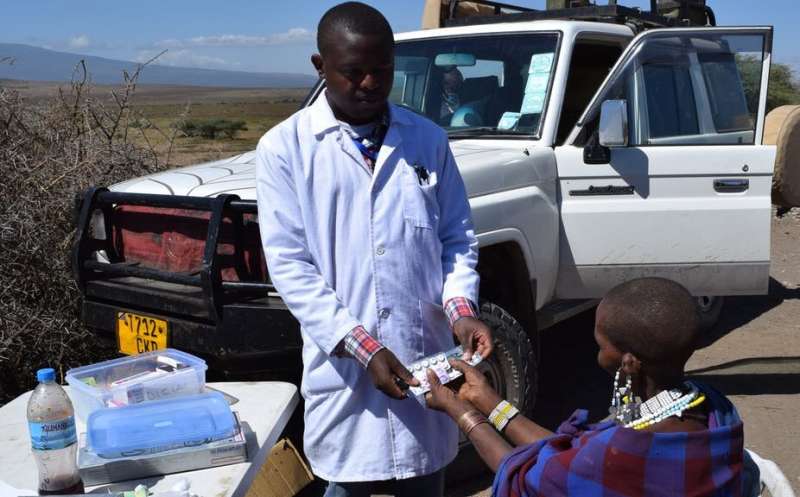Health system inequalities in East Africa drive antimicrobial resistance

The COVID pandemic has exposed long-standing structural fault lines in societies—especially in health systems. These same inequalities also drive another major global health concern: antimicrobial resistance.
The World Health Organization defines antimicrobial resistance as the process by which microbes change over time and no longer respond to medicines. This makes infections harder to treat. It also increases the risk of disease spread, severe illness and death. Resistance of bacteria to antibiotics is especially worrying.
Global deaths from antimicrobial resistance are projected to increase from the current 700,000 a year to 10 million by 2050. These losses disproportionately affect the world's poorest and most vulnerable populations in low- and middle-income countries. For example, across sub-Saharan Africa, rates of deaths due to antibiotic resistance are 24 per 100,000 people. In high-income countries, the death rate is 13 per 100,000.
Antimicrobial resistance is a complex problem and difficult to tackle. It also encompasses a broad range of factors. These include the biomedical, political, economic and socio-cultural, and go beyond individual disciplines and sectors. Yet most efforts to address antimicrobial resistance tend to use a biomedical lens. These efforts fail to consider the experiences of those most affected, including those responsible for health provision and those receiving it.
Our research in East Africa moves away from this narrow biomedical focus. Our goal is to bring to light the everyday experiences and struggles of diverse stakeholders. We wanted to demonstrate the impact of antimicrobial resistance challenges on the lives of healthcare providers and patients as well as farmers caring for their livestock in East Africa.
Understanding local experiences, motivations and challenges of healthcare providers and patients is a vital step in designing sustainable health interventions that directly address the concerns voiced by the intended beneficiaries.
Healthcare challenges
Increasing levels of bacterial resistance to a range of commonly used antibiotics have been reported in hospital settings and communities with livestock in East Africa. Our research investigated how antimicrobial resistance fits into the broader health challenges of the region. We used qualitative social science to gather the perspectives of health providers in major regional and rural health centres, their patients, and livestock farmers.
From the interviews, we identified three main kinds of challenges people faced in delivering and receiving healthcare:
- the capacity of healthcare infrastructure
- access and choice around healthcare
- health communications.
We see inequalities experienced across settings and populations, however they are more acutely felt in the most remote, rural communities. Likewise, those with less social power (notably women and children) also tend to face considerable challenges. In these constrained circumstances, people sometimes resorted to self-treatment. The combination of these factors could lead to antimicrobial resistance because of the way drugs are prescribed, accessed and used.
Infrastructural challenges occurred at all levels of the health system. Respondents reported shortages of healthcare staff, supplies, laboratory equipment to correctly diagnose infections, personal protective gear, infection control resources and people's time. For example, drugs of appropriate quality were not always available. This presented the risk that patients might receive medication levels that would not clear infection and could promote resistance. Ineffective drugs could also inflict economic hardship by eating into the limited budgets of families and health systems who need to treat multiple times or buy additional drugs for a single problem.
Lack of basic infrastructure like roads and phone networks or diagnostics can limit people's ability to make good health choices. The state of transport, roads, phones and internet—all necessary to link and support people in the healthcare system—was limited in our study areas.
Thus, tied to infrastructure is the issue of access to available services. This is critical for patients and providers. Access encompasses not only when and where services are available, but to whom. Access is also linked to presence of care, trust in that care and feeling empowered to make and act on good health decisions.
When people do not feel empowered or do not trust their care options, this can lead to self-treatment without professional advice. Hence the concerns around the development and spread of antimicrobial resistance in people and livestock.
Our participants, both providers and patients, expressed how communication and identifying trusted sources of information was important in their healthcare experiences. Yet the responsibility for good health tends to fall on individuals. Patients are blamed for not following guidance or for taking steps of self-care that create a risk of antimicrobial resistance.
Patients looking for information did not always feel providers listened to them or gave adequate guidance. Providers felt pressured by patients to prescribe drugs even when they were not needed. They said patients did not understand the constraints they were under. We saw how unhelpful cycles of blame could be triggered.
These findings are similar to an earlier review we carried out which showed that these issues are widespread across East Africa.
Collective responsibility
There is a global consensus that universal access to healthcare is an essential human right and critical to sustainable development. But major disparities between and within countries still exist.
The fissures and fault lines of the health system we highlight show what individuals, families and communities face when trying to obtain healthcare.
Antimicrobial resistance exists in this wider historical and socio-political context. The fight against antimicrobial resistance must proceed in a way that tackles, rather than reproduces, existing health inequalities. To do so, more voices need to be heard.
Avoidable suffering and death need to be addressed by broadening access to critical health infrastructure, improving health communications and rethinking the narrative of health not solely as an individual responsibility, but as a public good.
This article is republished from The Conversation under a Creative Commons license. Read the original article.![]()





















